Sociology: Analyzing the Interplay of Poverty, Ethnicity, and Age
VerifiedAdded on 2023/06/03
|9
|2485
|440
Essay
AI Summary
This essay provides a sociological analysis of poverty, focusing on its impact on individuals and families, and examining the roles of ethnicity and age. It highlights the themes of poor health and lack of education as consequences of poverty, using examples from various countries. The essay also discusses the ethnic disparities in income and poverty in Great Britain, and the issue of old age poverty in America, emphasizing the impact of low wages and social exclusion. Furthermore, it analyzes a specific case study to illustrate the socioeconomic factors contributing to poverty and inequality. Desklib offers a wealth of similar solved assignments and past papers to aid students in their studies.
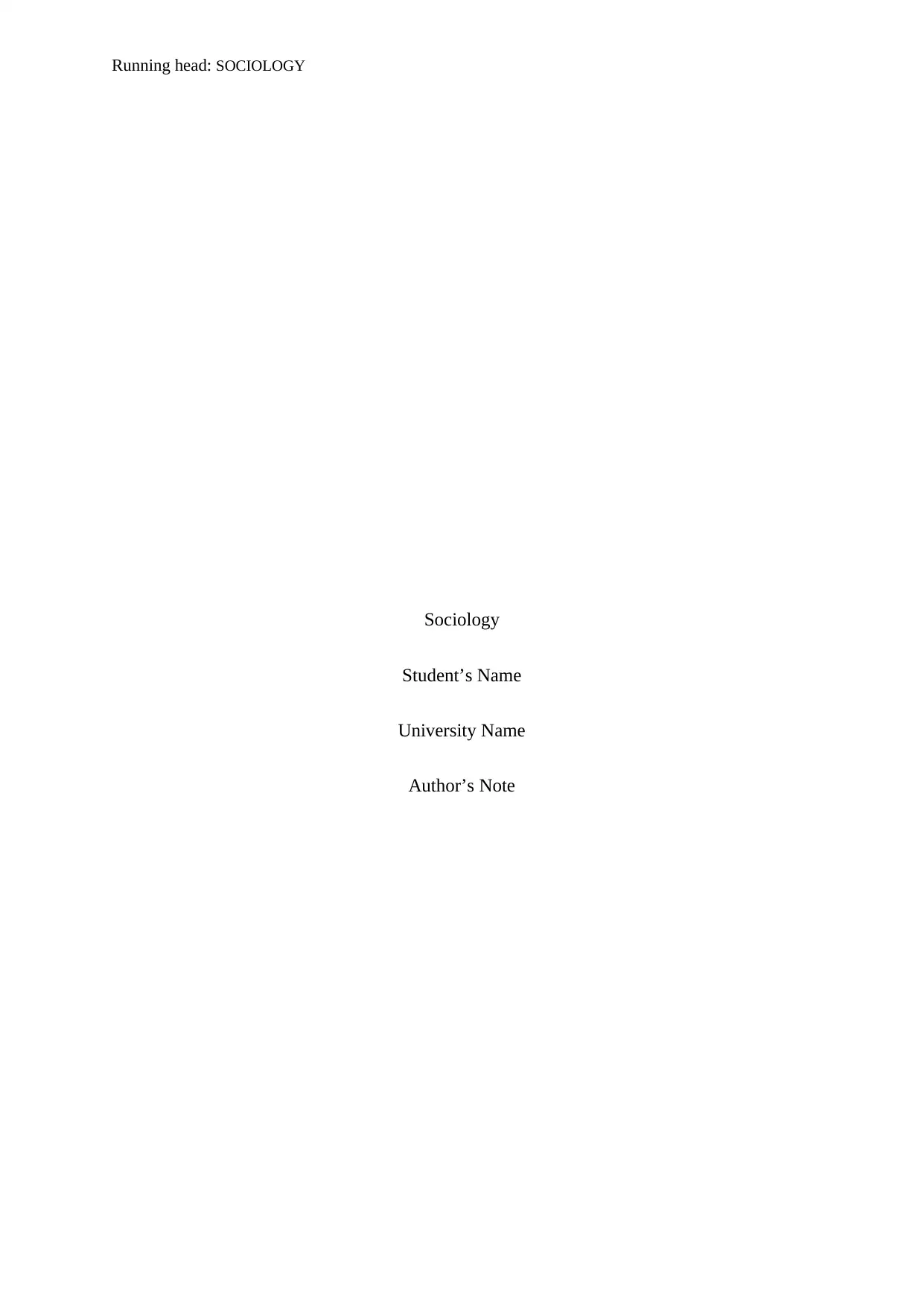
Running head: SOCIOLOGY
Sociology
Student’s Name
University Name
Author’s Note
Sociology
Student’s Name
University Name
Author’s Note
Paraphrase This Document
Need a fresh take? Get an instant paraphrase of this document with our AI Paraphraser

2SOCIOLOGY
Table of Contents
1. Impact of Poverty on Individuals and families......................................................................3
1.1 Theme 1: Poor Health.......................................................................................................3
1.2 Theme 2: Dearth of Education.........................................................................................3
2. Impact of ethnicity and age on Poverty..................................................................................4
2.1 Impact of Ethnicity on poverty.........................................................................................4
2.2 Old Age Poverty...............................................................................................................5
3. Analysis of Particular Story: chapter 20: nobody wants the north side.................................6
Reference List............................................................................................................................8
Table of Contents
1. Impact of Poverty on Individuals and families......................................................................3
1.1 Theme 1: Poor Health.......................................................................................................3
1.2 Theme 2: Dearth of Education.........................................................................................3
2. Impact of ethnicity and age on Poverty..................................................................................4
2.1 Impact of Ethnicity on poverty.........................................................................................4
2.2 Old Age Poverty...............................................................................................................5
3. Analysis of Particular Story: chapter 20: nobody wants the north side.................................6
Reference List............................................................................................................................8
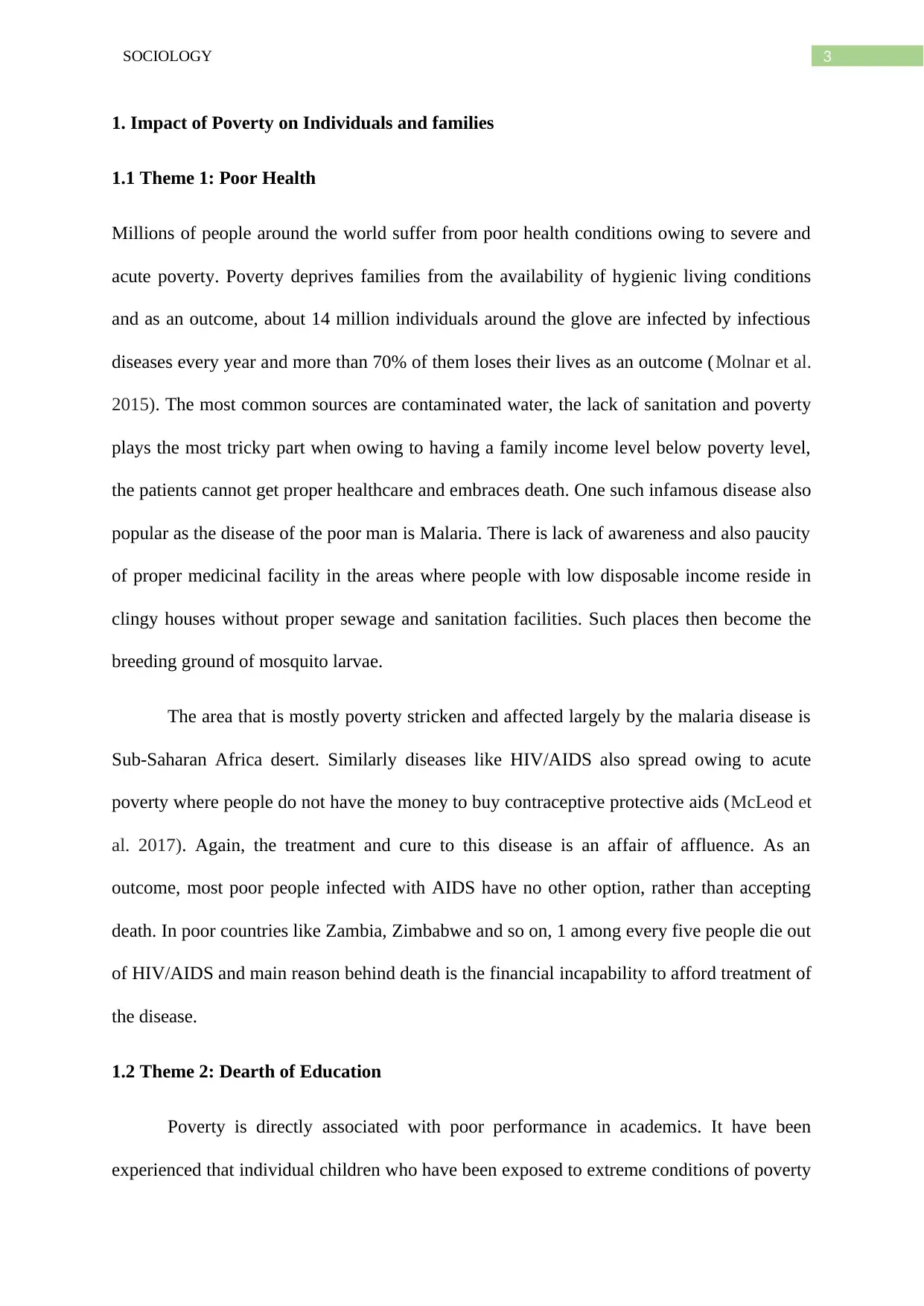
3SOCIOLOGY
1. Impact of Poverty on Individuals and families
1.1 Theme 1: Poor Health
Millions of people around the world suffer from poor health conditions owing to severe and
acute poverty. Poverty deprives families from the availability of hygienic living conditions
and as an outcome, about 14 million individuals around the glove are infected by infectious
diseases every year and more than 70% of them loses their lives as an outcome (Molnar et al.
2015). The most common sources are contaminated water, the lack of sanitation and poverty
plays the most tricky part when owing to having a family income level below poverty level,
the patients cannot get proper healthcare and embraces death. One such infamous disease also
popular as the disease of the poor man is Malaria. There is lack of awareness and also paucity
of proper medicinal facility in the areas where people with low disposable income reside in
clingy houses without proper sewage and sanitation facilities. Such places then become the
breeding ground of mosquito larvae.
The area that is mostly poverty stricken and affected largely by the malaria disease is
Sub-Saharan Africa desert. Similarly diseases like HIV/AIDS also spread owing to acute
poverty where people do not have the money to buy contraceptive protective aids (McLeod et
al. 2017). Again, the treatment and cure to this disease is an affair of affluence. As an
outcome, most poor people infected with AIDS have no other option, rather than accepting
death. In poor countries like Zambia, Zimbabwe and so on, 1 among every five people die out
of HIV/AIDS and main reason behind death is the financial incapability to afford treatment of
the disease.
1.2 Theme 2: Dearth of Education
Poverty is directly associated with poor performance in academics. It have been
experienced that individual children who have been exposed to extreme conditions of poverty
1. Impact of Poverty on Individuals and families
1.1 Theme 1: Poor Health
Millions of people around the world suffer from poor health conditions owing to severe and
acute poverty. Poverty deprives families from the availability of hygienic living conditions
and as an outcome, about 14 million individuals around the glove are infected by infectious
diseases every year and more than 70% of them loses their lives as an outcome (Molnar et al.
2015). The most common sources are contaminated water, the lack of sanitation and poverty
plays the most tricky part when owing to having a family income level below poverty level,
the patients cannot get proper healthcare and embraces death. One such infamous disease also
popular as the disease of the poor man is Malaria. There is lack of awareness and also paucity
of proper medicinal facility in the areas where people with low disposable income reside in
clingy houses without proper sewage and sanitation facilities. Such places then become the
breeding ground of mosquito larvae.
The area that is mostly poverty stricken and affected largely by the malaria disease is
Sub-Saharan Africa desert. Similarly diseases like HIV/AIDS also spread owing to acute
poverty where people do not have the money to buy contraceptive protective aids (McLeod et
al. 2017). Again, the treatment and cure to this disease is an affair of affluence. As an
outcome, most poor people infected with AIDS have no other option, rather than accepting
death. In poor countries like Zambia, Zimbabwe and so on, 1 among every five people die out
of HIV/AIDS and main reason behind death is the financial incapability to afford treatment of
the disease.
1.2 Theme 2: Dearth of Education
Poverty is directly associated with poor performance in academics. It have been
experienced that individual children who have been exposed to extreme conditions of poverty
⊘ This is a preview!⊘
Do you want full access?
Subscribe today to unlock all pages.

Trusted by 1+ million students worldwide
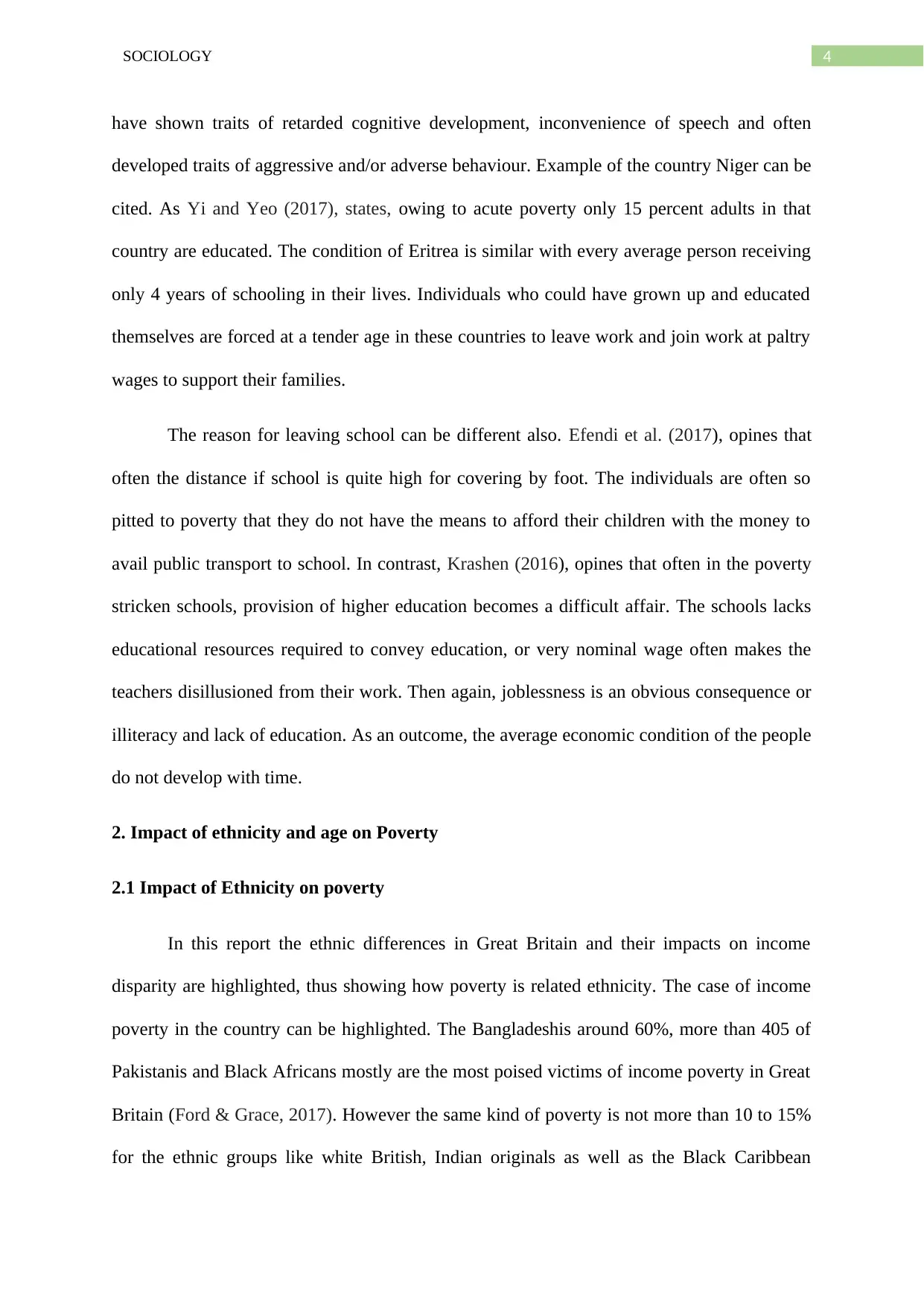
4SOCIOLOGY
have shown traits of retarded cognitive development, inconvenience of speech and often
developed traits of aggressive and/or adverse behaviour. Example of the country Niger can be
cited. As Yi and Yeo (2017), states, owing to acute poverty only 15 percent adults in that
country are educated. The condition of Eritrea is similar with every average person receiving
only 4 years of schooling in their lives. Individuals who could have grown up and educated
themselves are forced at a tender age in these countries to leave work and join work at paltry
wages to support their families.
The reason for leaving school can be different also. Efendi et al. (2017), opines that
often the distance if school is quite high for covering by foot. The individuals are often so
pitted to poverty that they do not have the means to afford their children with the money to
avail public transport to school. In contrast, Krashen (2016), opines that often in the poverty
stricken schools, provision of higher education becomes a difficult affair. The schools lacks
educational resources required to convey education, or very nominal wage often makes the
teachers disillusioned from their work. Then again, joblessness is an obvious consequence or
illiteracy and lack of education. As an outcome, the average economic condition of the people
do not develop with time.
2. Impact of ethnicity and age on Poverty
2.1 Impact of Ethnicity on poverty
In this report the ethnic differences in Great Britain and their impacts on income
disparity are highlighted, thus showing how poverty is related ethnicity. The case of income
poverty in the country can be highlighted. The Bangladeshis around 60%, more than 405 of
Pakistanis and Black Africans mostly are the most poised victims of income poverty in Great
Britain (Ford & Grace, 2017). However the same kind of poverty is not more than 10 to 15%
for the ethnic groups like white British, Indian originals as well as the Black Caribbean
have shown traits of retarded cognitive development, inconvenience of speech and often
developed traits of aggressive and/or adverse behaviour. Example of the country Niger can be
cited. As Yi and Yeo (2017), states, owing to acute poverty only 15 percent adults in that
country are educated. The condition of Eritrea is similar with every average person receiving
only 4 years of schooling in their lives. Individuals who could have grown up and educated
themselves are forced at a tender age in these countries to leave work and join work at paltry
wages to support their families.
The reason for leaving school can be different also. Efendi et al. (2017), opines that
often the distance if school is quite high for covering by foot. The individuals are often so
pitted to poverty that they do not have the means to afford their children with the money to
avail public transport to school. In contrast, Krashen (2016), opines that often in the poverty
stricken schools, provision of higher education becomes a difficult affair. The schools lacks
educational resources required to convey education, or very nominal wage often makes the
teachers disillusioned from their work. Then again, joblessness is an obvious consequence or
illiteracy and lack of education. As an outcome, the average economic condition of the people
do not develop with time.
2. Impact of ethnicity and age on Poverty
2.1 Impact of Ethnicity on poverty
In this report the ethnic differences in Great Britain and their impacts on income
disparity are highlighted, thus showing how poverty is related ethnicity. The case of income
poverty in the country can be highlighted. The Bangladeshis around 60%, more than 405 of
Pakistanis and Black Africans mostly are the most poised victims of income poverty in Great
Britain (Ford & Grace, 2017). However the same kind of poverty is not more than 10 to 15%
for the ethnic groups like white British, Indian originals as well as the Black Caribbean
Paraphrase This Document
Need a fresh take? Get an instant paraphrase of this document with our AI Paraphraser
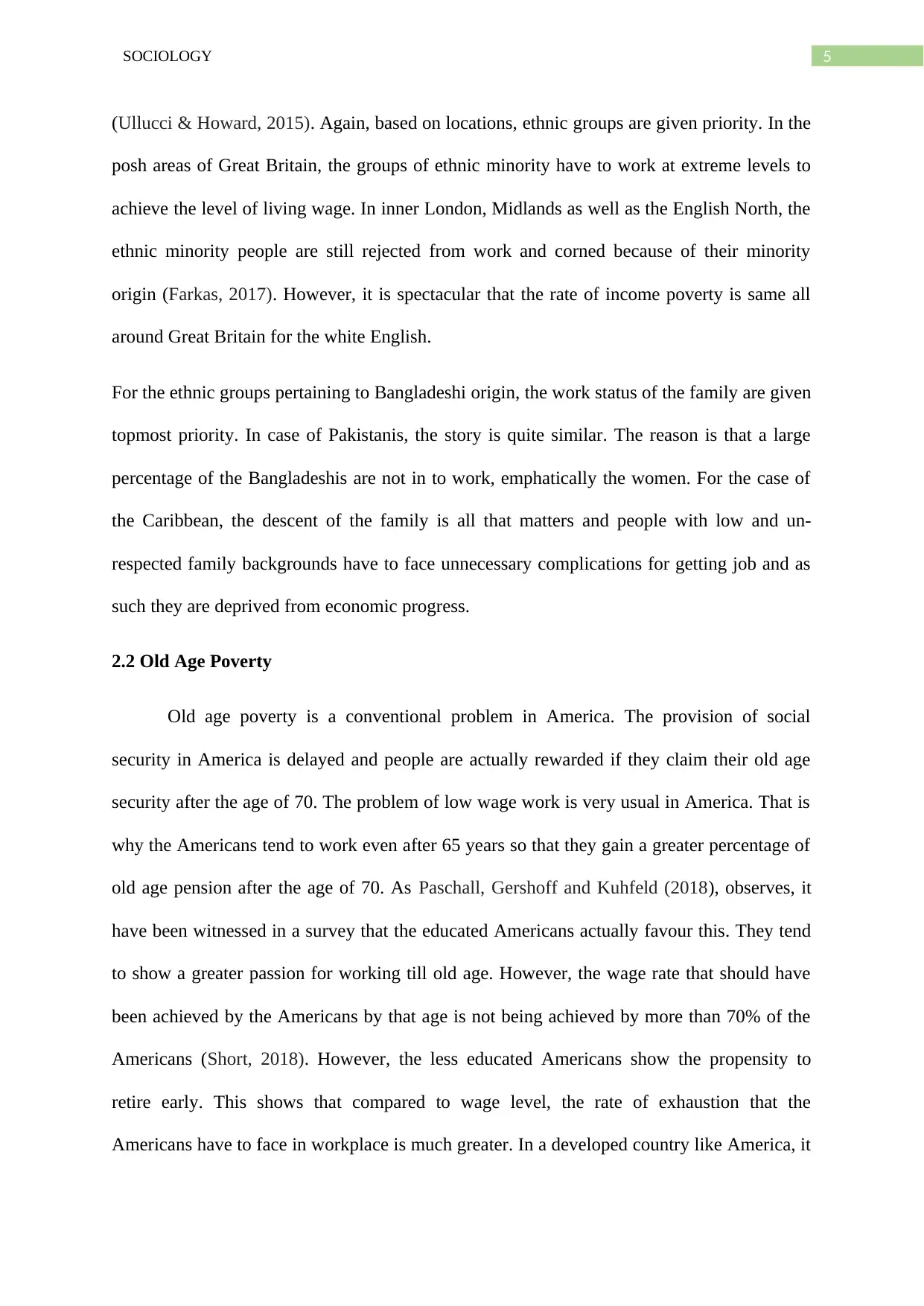
5SOCIOLOGY
(Ullucci & Howard, 2015). Again, based on locations, ethnic groups are given priority. In the
posh areas of Great Britain, the groups of ethnic minority have to work at extreme levels to
achieve the level of living wage. In inner London, Midlands as well as the English North, the
ethnic minority people are still rejected from work and corned because of their minority
origin (Farkas, 2017). However, it is spectacular that the rate of income poverty is same all
around Great Britain for the white English.
For the ethnic groups pertaining to Bangladeshi origin, the work status of the family are given
topmost priority. In case of Pakistanis, the story is quite similar. The reason is that a large
percentage of the Bangladeshis are not in to work, emphatically the women. For the case of
the Caribbean, the descent of the family is all that matters and people with low and un-
respected family backgrounds have to face unnecessary complications for getting job and as
such they are deprived from economic progress.
2.2 Old Age Poverty
Old age poverty is a conventional problem in America. The provision of social
security in America is delayed and people are actually rewarded if they claim their old age
security after the age of 70. The problem of low wage work is very usual in America. That is
why the Americans tend to work even after 65 years so that they gain a greater percentage of
old age pension after the age of 70. As Paschall, Gershoff and Kuhfeld (2018), observes, it
have been witnessed in a survey that the educated Americans actually favour this. They tend
to show a greater passion for working till old age. However, the wage rate that should have
been achieved by the Americans by that age is not being achieved by more than 70% of the
Americans (Short, 2018). However, the less educated Americans show the propensity to
retire early. This shows that compared to wage level, the rate of exhaustion that the
Americans have to face in workplace is much greater. In a developed country like America, it
(Ullucci & Howard, 2015). Again, based on locations, ethnic groups are given priority. In the
posh areas of Great Britain, the groups of ethnic minority have to work at extreme levels to
achieve the level of living wage. In inner London, Midlands as well as the English North, the
ethnic minority people are still rejected from work and corned because of their minority
origin (Farkas, 2017). However, it is spectacular that the rate of income poverty is same all
around Great Britain for the white English.
For the ethnic groups pertaining to Bangladeshi origin, the work status of the family are given
topmost priority. In case of Pakistanis, the story is quite similar. The reason is that a large
percentage of the Bangladeshis are not in to work, emphatically the women. For the case of
the Caribbean, the descent of the family is all that matters and people with low and un-
respected family backgrounds have to face unnecessary complications for getting job and as
such they are deprived from economic progress.
2.2 Old Age Poverty
Old age poverty is a conventional problem in America. The provision of social
security in America is delayed and people are actually rewarded if they claim their old age
security after the age of 70. The problem of low wage work is very usual in America. That is
why the Americans tend to work even after 65 years so that they gain a greater percentage of
old age pension after the age of 70. As Paschall, Gershoff and Kuhfeld (2018), observes, it
have been witnessed in a survey that the educated Americans actually favour this. They tend
to show a greater passion for working till old age. However, the wage rate that should have
been achieved by the Americans by that age is not being achieved by more than 70% of the
Americans (Short, 2018). However, the less educated Americans show the propensity to
retire early. This shows that compared to wage level, the rate of exhaustion that the
Americans have to face in workplace is much greater. In a developed country like America, it
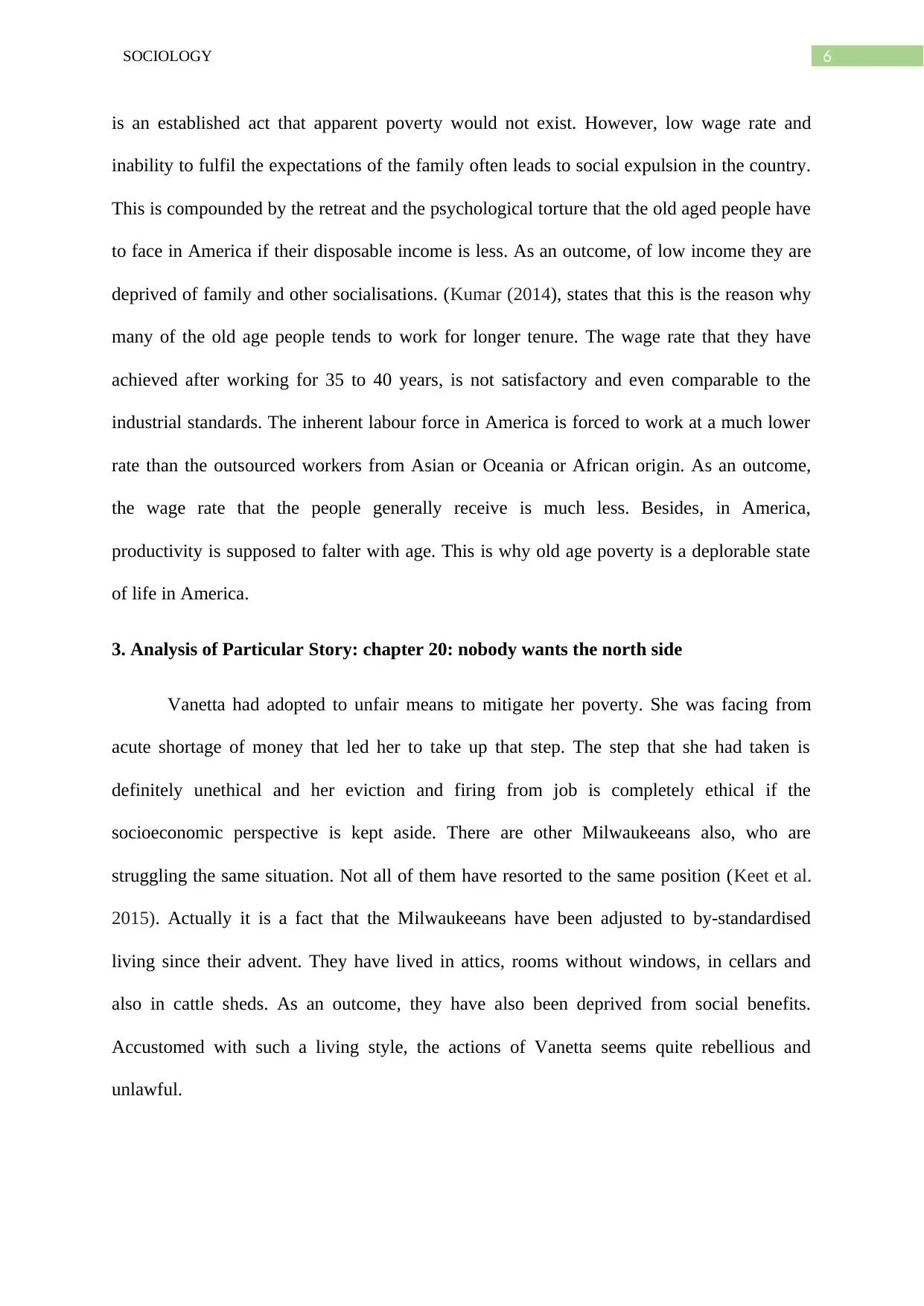
6SOCIOLOGY
is an established act that apparent poverty would not exist. However, low wage rate and
inability to fulfil the expectations of the family often leads to social expulsion in the country.
This is compounded by the retreat and the psychological torture that the old aged people have
to face in America if their disposable income is less. As an outcome, of low income they are
deprived of family and other socialisations. (Kumar (2014), states that this is the reason why
many of the old age people tends to work for longer tenure. The wage rate that they have
achieved after working for 35 to 40 years, is not satisfactory and even comparable to the
industrial standards. The inherent labour force in America is forced to work at a much lower
rate than the outsourced workers from Asian or Oceania or African origin. As an outcome,
the wage rate that the people generally receive is much less. Besides, in America,
productivity is supposed to falter with age. This is why old age poverty is a deplorable state
of life in America.
3. Analysis of Particular Story: chapter 20: nobody wants the north side
Vanetta had adopted to unfair means to mitigate her poverty. She was facing from
acute shortage of money that led her to take up that step. The step that she had taken is
definitely unethical and her eviction and firing from job is completely ethical if the
socioeconomic perspective is kept aside. There are other Milwaukeeans also, who are
struggling the same situation. Not all of them have resorted to the same position (Keet et al.
2015). Actually it is a fact that the Milwaukeeans have been adjusted to by-standardised
living since their advent. They have lived in attics, rooms without windows, in cellars and
also in cattle sheds. As an outcome, they have also been deprived from social benefits.
Accustomed with such a living style, the actions of Vanetta seems quite rebellious and
unlawful.
is an established act that apparent poverty would not exist. However, low wage rate and
inability to fulfil the expectations of the family often leads to social expulsion in the country.
This is compounded by the retreat and the psychological torture that the old aged people have
to face in America if their disposable income is less. As an outcome, of low income they are
deprived of family and other socialisations. (Kumar (2014), states that this is the reason why
many of the old age people tends to work for longer tenure. The wage rate that they have
achieved after working for 35 to 40 years, is not satisfactory and even comparable to the
industrial standards. The inherent labour force in America is forced to work at a much lower
rate than the outsourced workers from Asian or Oceania or African origin. As an outcome,
the wage rate that the people generally receive is much less. Besides, in America,
productivity is supposed to falter with age. This is why old age poverty is a deplorable state
of life in America.
3. Analysis of Particular Story: chapter 20: nobody wants the north side
Vanetta had adopted to unfair means to mitigate her poverty. She was facing from
acute shortage of money that led her to take up that step. The step that she had taken is
definitely unethical and her eviction and firing from job is completely ethical if the
socioeconomic perspective is kept aside. There are other Milwaukeeans also, who are
struggling the same situation. Not all of them have resorted to the same position (Keet et al.
2015). Actually it is a fact that the Milwaukeeans have been adjusted to by-standardised
living since their advent. They have lived in attics, rooms without windows, in cellars and
also in cattle sheds. As an outcome, they have also been deprived from social benefits.
Accustomed with such a living style, the actions of Vanetta seems quite rebellious and
unlawful.
⊘ This is a preview!⊘
Do you want full access?
Subscribe today to unlock all pages.

Trusted by 1+ million students worldwide

7SOCIOLOGY
However, if the same scenario is analysed from a socioeconomic perception. Then the
deplorable condition of the poverty stricken people like Vanetta in this city becomes evident.
The racial discrimination and ethnicity based income disparity that is practiced here is
evident through the case of Vanetta. The Milwaukeeans have never gained a respectable
place in the city. They have been extorted and race based housing discrimination is a hard
reality that people like Vanetta have been facing since long. Racial discrimination have been
so prominent that the places and slums where these people used to inhabit have been deprived
of basic municipal services like establishment of local wells, sanitary services and so on. At
one stage, these people were so poor that they were not able to pay their room rent and the
law gave the landlords the rights to sell off their property to extract the rent. As obvious
outcome of this terrible condition have been the large death rate of the Milwaukeeans in the
1930s (Desmond, 2016). More than 60% of the Milwaukeeans died in the city (Desmond,
2016). The state policies were also against them. It had deprived the blacks like
Milwaukeeans from any rights of house-ownership. As an outcome, if they had to survive in
this city they had to rely on rented houses. On top of that the house owners were oppressive
and exploited them which made them more poor. This is why, Vanetta had attempted
something extreme to break off this extreme poverty and the act of robbing was her display of
revenge against this age old poverty and negligence towards people of her race and ethnicity.
However, if the same scenario is analysed from a socioeconomic perception. Then the
deplorable condition of the poverty stricken people like Vanetta in this city becomes evident.
The racial discrimination and ethnicity based income disparity that is practiced here is
evident through the case of Vanetta. The Milwaukeeans have never gained a respectable
place in the city. They have been extorted and race based housing discrimination is a hard
reality that people like Vanetta have been facing since long. Racial discrimination have been
so prominent that the places and slums where these people used to inhabit have been deprived
of basic municipal services like establishment of local wells, sanitary services and so on. At
one stage, these people were so poor that they were not able to pay their room rent and the
law gave the landlords the rights to sell off their property to extract the rent. As obvious
outcome of this terrible condition have been the large death rate of the Milwaukeeans in the
1930s (Desmond, 2016). More than 60% of the Milwaukeeans died in the city (Desmond,
2016). The state policies were also against them. It had deprived the blacks like
Milwaukeeans from any rights of house-ownership. As an outcome, if they had to survive in
this city they had to rely on rented houses. On top of that the house owners were oppressive
and exploited them which made them more poor. This is why, Vanetta had attempted
something extreme to break off this extreme poverty and the act of robbing was her display of
revenge against this age old poverty and negligence towards people of her race and ethnicity.
Paraphrase This Document
Need a fresh take? Get an instant paraphrase of this document with our AI Paraphraser

8SOCIOLOGY
Reference List
Desmond, M. (2016). Evicted: Poverty and Profit in the American City. PenGuin Random
House: Broadway. Retrieved on 24th October 2018. Retrieved from
http://evictedbook.com/wp-content/uploads/2017/06/EVICTED.DESMOND.978-0-
553-44745-3.InstructG_PG.16pgs.FINAL_.NO_CROPS.pdf
Efendi, A., Nababan, Y., Sari, K. N., Indriani, R., & Hodge, G. (2017). The Impact of Health
and Education on Poverty Reduction: A Causal Analysis. The Third Research Dive
on Statistics for Sustainable Development Goals, 8.
Farkas, G. (2017). Human capital or cultural capital?: Ethnicity and poverty groups in an
urban school district. Routledge.
Ford, O. D., & Grace, R. (2017). The Impact of Poverty on Student Outcomes. The Alabama
Journal of Educational Leadership, 15.
Keet, C. A., McCormack, M. C., Pollack, C. E., Peng, R. D., McGowan, E., & Matsui, E. C.
(2015). Neighborhood poverty, urban residence, race/ethnicity, and asthma:
rethinking the inner-city asthma epidemic. Journal of Allergy and Clinical
Immunology, 135(3), 655-662.
Krashen, S. (2016). The purpose of education, free voluntary reading, and dealing with the
impact of poverty. School Libraries Worldwide, 22(1), 1.
Kumar, A. (2014). Access to basic amenities: Aspects of caste, ethnicity and poverty in rural
and urban India—1993 to 2008–2009. Journal of Land and Rural Studies, 2(1), 127-
148.
McLeod, S., Mulder, C., McGregor, M., Katz, A., Singer, A., Liddy, C., ... & Viner, G.
(2017). Family Medicine Forum Research Proceedings 2016Do urine cultures in the
Reference List
Desmond, M. (2016). Evicted: Poverty and Profit in the American City. PenGuin Random
House: Broadway. Retrieved on 24th October 2018. Retrieved from
http://evictedbook.com/wp-content/uploads/2017/06/EVICTED.DESMOND.978-0-
553-44745-3.InstructG_PG.16pgs.FINAL_.NO_CROPS.pdf
Efendi, A., Nababan, Y., Sari, K. N., Indriani, R., & Hodge, G. (2017). The Impact of Health
and Education on Poverty Reduction: A Causal Analysis. The Third Research Dive
on Statistics for Sustainable Development Goals, 8.
Farkas, G. (2017). Human capital or cultural capital?: Ethnicity and poverty groups in an
urban school district. Routledge.
Ford, O. D., & Grace, R. (2017). The Impact of Poverty on Student Outcomes. The Alabama
Journal of Educational Leadership, 15.
Keet, C. A., McCormack, M. C., Pollack, C. E., Peng, R. D., McGowan, E., & Matsui, E. C.
(2015). Neighborhood poverty, urban residence, race/ethnicity, and asthma:
rethinking the inner-city asthma epidemic. Journal of Allergy and Clinical
Immunology, 135(3), 655-662.
Krashen, S. (2016). The purpose of education, free voluntary reading, and dealing with the
impact of poverty. School Libraries Worldwide, 22(1), 1.
Kumar, A. (2014). Access to basic amenities: Aspects of caste, ethnicity and poverty in rural
and urban India—1993 to 2008–2009. Journal of Land and Rural Studies, 2(1), 127-
148.
McLeod, S., Mulder, C., McGregor, M., Katz, A., Singer, A., Liddy, C., ... & Viner, G.
(2017). Family Medicine Forum Research Proceedings 2016Do urine cultures in the
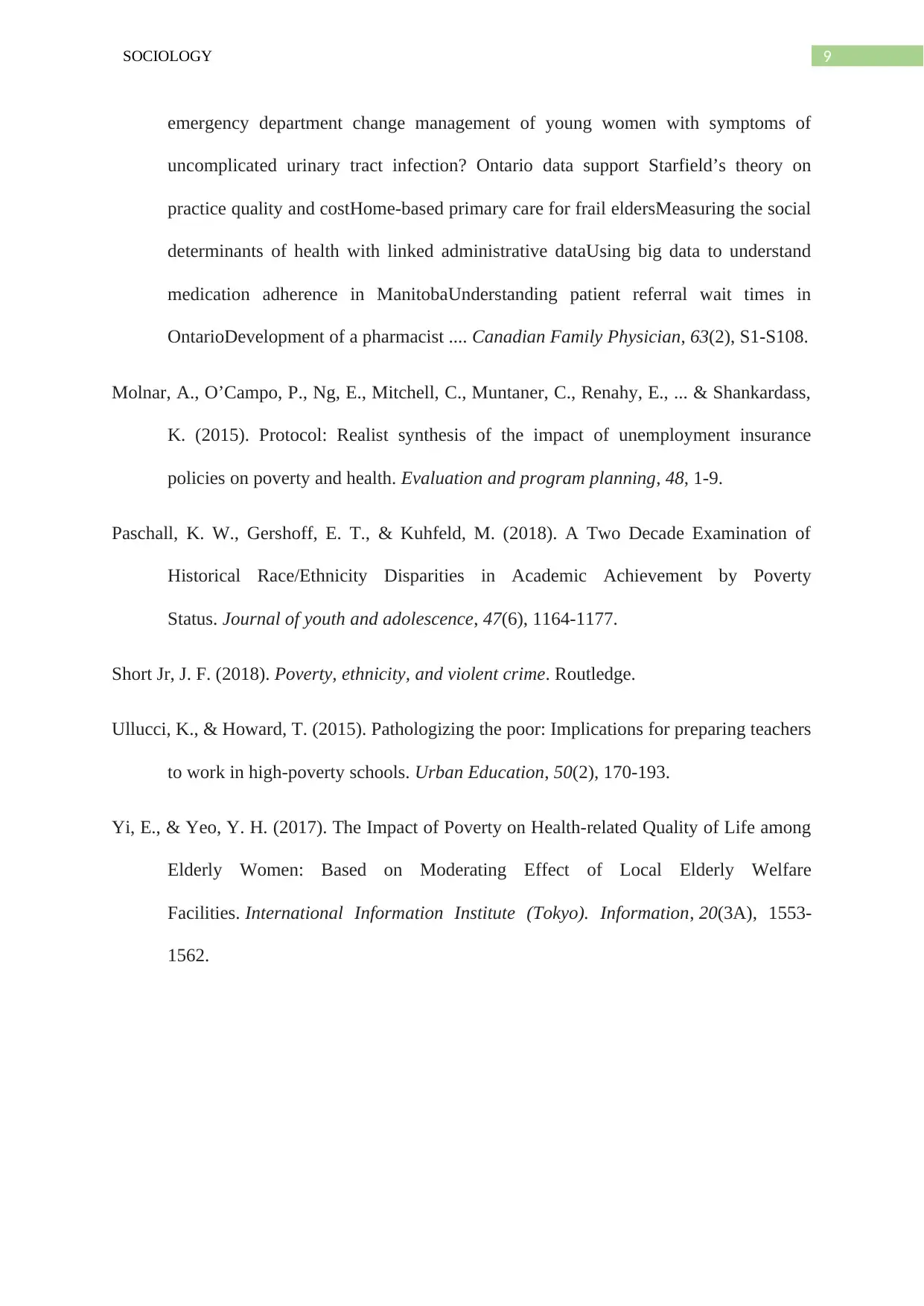
9SOCIOLOGY
emergency department change management of young women with symptoms of
uncomplicated urinary tract infection? Ontario data support Starfield’s theory on
practice quality and costHome-based primary care for frail eldersMeasuring the social
determinants of health with linked administrative dataUsing big data to understand
medication adherence in ManitobaUnderstanding patient referral wait times in
OntarioDevelopment of a pharmacist .... Canadian Family Physician, 63(2), S1-S108.
Molnar, A., O’Campo, P., Ng, E., Mitchell, C., Muntaner, C., Renahy, E., ... & Shankardass,
K. (2015). Protocol: Realist synthesis of the impact of unemployment insurance
policies on poverty and health. Evaluation and program planning, 48, 1-9.
Paschall, K. W., Gershoff, E. T., & Kuhfeld, M. (2018). A Two Decade Examination of
Historical Race/Ethnicity Disparities in Academic Achievement by Poverty
Status. Journal of youth and adolescence, 47(6), 1164-1177.
Short Jr, J. F. (2018). Poverty, ethnicity, and violent crime. Routledge.
Ullucci, K., & Howard, T. (2015). Pathologizing the poor: Implications for preparing teachers
to work in high-poverty schools. Urban Education, 50(2), 170-193.
Yi, E., & Yeo, Y. H. (2017). The Impact of Poverty on Health-related Quality of Life among
Elderly Women: Based on Moderating Effect of Local Elderly Welfare
Facilities. International Information Institute (Tokyo). Information, 20(3A), 1553-
1562.
emergency department change management of young women with symptoms of
uncomplicated urinary tract infection? Ontario data support Starfield’s theory on
practice quality and costHome-based primary care for frail eldersMeasuring the social
determinants of health with linked administrative dataUsing big data to understand
medication adherence in ManitobaUnderstanding patient referral wait times in
OntarioDevelopment of a pharmacist .... Canadian Family Physician, 63(2), S1-S108.
Molnar, A., O’Campo, P., Ng, E., Mitchell, C., Muntaner, C., Renahy, E., ... & Shankardass,
K. (2015). Protocol: Realist synthesis of the impact of unemployment insurance
policies on poverty and health. Evaluation and program planning, 48, 1-9.
Paschall, K. W., Gershoff, E. T., & Kuhfeld, M. (2018). A Two Decade Examination of
Historical Race/Ethnicity Disparities in Academic Achievement by Poverty
Status. Journal of youth and adolescence, 47(6), 1164-1177.
Short Jr, J. F. (2018). Poverty, ethnicity, and violent crime. Routledge.
Ullucci, K., & Howard, T. (2015). Pathologizing the poor: Implications for preparing teachers
to work in high-poverty schools. Urban Education, 50(2), 170-193.
Yi, E., & Yeo, Y. H. (2017). The Impact of Poverty on Health-related Quality of Life among
Elderly Women: Based on Moderating Effect of Local Elderly Welfare
Facilities. International Information Institute (Tokyo). Information, 20(3A), 1553-
1562.
⊘ This is a preview!⊘
Do you want full access?
Subscribe today to unlock all pages.

Trusted by 1+ million students worldwide
1 out of 9
Related Documents
Your All-in-One AI-Powered Toolkit for Academic Success.
+13062052269
info@desklib.com
Available 24*7 on WhatsApp / Email
![[object Object]](/_next/static/media/star-bottom.7253800d.svg)
Unlock your academic potential
Copyright © 2020–2025 A2Z Services. All Rights Reserved. Developed and managed by ZUCOL.





